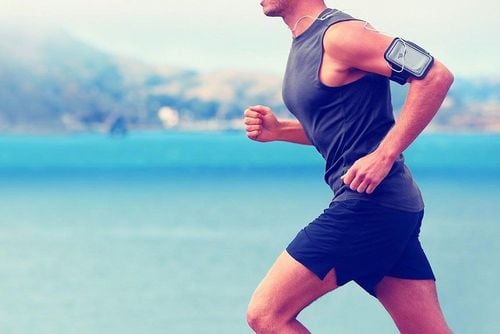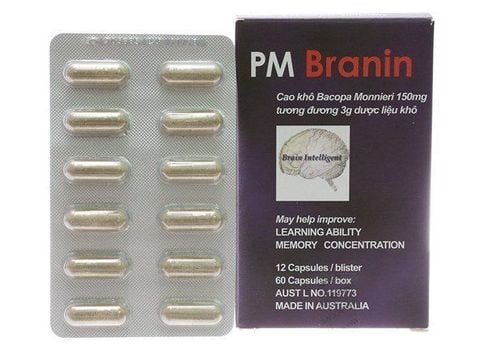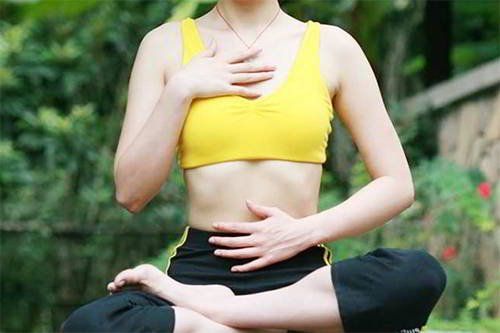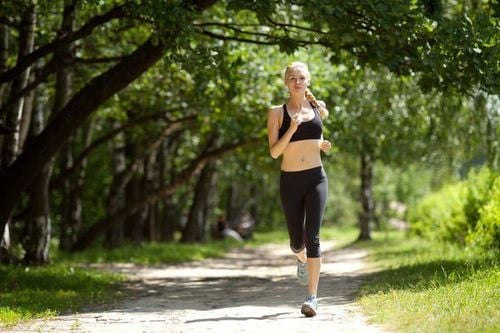This is an automatically translated article.
Have you ever noticed how you breathe deeply when you feel relaxed? Take a moment to notice how your body feels. Or think about how you breathe when you wake up in the morning or right before you fall asleep. Breathing exercises can help you relax. Learn more about deep breathing techniques to reduce stress in the article below.
1. The meaning of deep breathing
Deep breathing is one of the best ways to reduce stress in your body. This is because when we take a deep breath, our brain receives a message that makes the body calm and relax. The brain then sends this message to the entire body. Things that happen when we feel stressed, such as increased heart rate, rapid breathing, and high blood pressure, all decrease when you take deep breaths to relax. Remember, the way you breathe affects your entire body.
Take a deep breath. Now exhale. We may notice a difference in how you feel. Breathing is a powerful tool for alleviating stress and reducing feelings of anxiety. Some simple breathing exercises can make a big difference if we make them part of our regular routine. Breathing exercises are easy to learn. You can make them whenever you want and you don't need any special tools or equipment.
2. Deep breathing techniques to reduce and manage stress
There are many breathing exercises you can do to reduce and manage stress. The first exercise below - belly breathing - is simple to learn and easy to do. It is best for practitioners to start there if they have never practiced breathing before. There are also other exercises at a more advanced level. All these exercises can help us relax and reduce stress.
Before you start doing deep breathing techniques, keep these tips in mind:
Choose a place to do your breathing exercises. It could be in bed, on the living room floor, or on a chair that makes you feel most comfortable. Don't force yourself into performing these techniques. This can make us feel more stressed. Try to do it at the same time once or twice each day. Wear comfortable clothes. Many breathing exercises only take a few minutes. However, if you have more time, you can do them for 10 minutes or more to get even more benefits.
2.1. Belly breathing
Belly breathing is very easy to do and very relaxing. Try this basic exercise anytime you need to relieve stress. Steps to perform belly breathing techniques include:
Sit or lie flat in a comfortable position. Place one hand on your stomach just below your ribs and the other on your chest. Inhale deeply through your nose and let your belly push your hands out. Maintain the position of the chest. Exhale with pursed lips as if you were whistling. Feel the hand on your stomach come in and use it to push all the air out. Do this movement 3 to 10 times. Concentrate as much as possible on each breath. Notice how you feel at the end of the exercise.
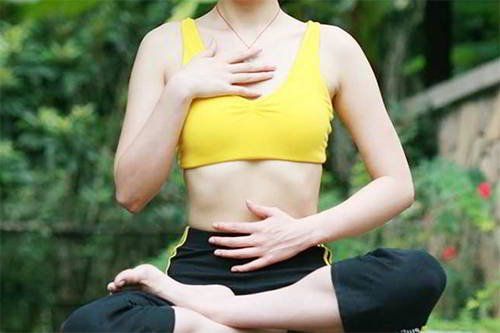
Hãy thử bài tập thở bằng bụng để giảm căng thẳng
2.2. Advanced breathing exercises
Once you've mastered the belly breathing technique, you may want to try one of these more advanced breathing exercises. My advice is to try all three and see which works best for you:
Breathing in rhythm 4 – 7 – 8 Rolling Breathing Morning breathing
2.2.1. Breathe in the rhythm of 4 - 7 - 8 minutes
This exercise also uses abdominal breathing to help us feel relaxed. The performer can also do this exercise while sitting or lying down. Steps to perform breathing exercises in rhythm 4 - 7 - 8 include:
To start, place one hand on your stomach and the other hand on your chest as in abdominal breathing exercises. Inhale deeply and slowly from the abdomen and count silently to 4 as you inhale. Hold your breath and count silently from 1 to 7. Exhale completely while counting from 1 to 8. Try to push all the air out of your lungs before counting to 8. Repeat 3 to 7 times or until you feel it. Calm. Notice how you feel at the end of the exercise.
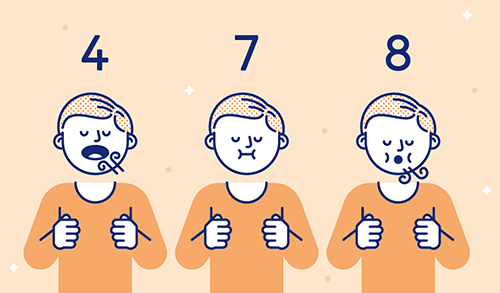
Bài tập thở theo nhịp 4-7-8 giúp giải tỏa căng thẳng
2.2.2. Breathe roll
Rolling breathing helps our body bring out the full effect of the lungs and focus on breathing. The executor can do it in any position. But while we are getting used to this exercise, it is best to lie on our back, knees bent. Steps to perform the roll breathing exercise include:
Place the left hand on the abdomen and the right hand on the chest. Notice how our hands move as we inhale and exhale. Practice filling the lower lungs by breathing so that the "belly" hand (left) rises when inhaling and the hand "chest" (right) remains still. Always inhale through your nose and exhale through your mouth. Do this 8 to 10 times. Once you've filled and emptied your lower lung 8 to 10 times, add a second step to the breathing process: First inhale into the lower lung as before, and then continue to inhale into the upper chest. Breathe slowly and steadily. In doing so, our right hand will rise and the left hand will lower slightly as the abdomen lowers. When exhaling slowly through the mouth, make a soft sound as the left hand descends first and then the right hand lowers. As we exhale, the feeling of tension leaves the body and causes us to become more and more relaxed. Practice inhaling and exhaling this way for 3 to 5 minutes. Notice that the movement of the abdomen and chest will rise and fall like the motion of a rolling wave. Notice how you feel when you finish the exercise. Practice rolling breathing daily for a few weeks until you feel you can do it anywhere. You can use it as an instant relaxation tool at any time you need. Note however: Some people get dizzy the first few times they try coiling. If you start to breathe too fast or feel dizzy, slow your breathing, then slowly stand up.
2.2.3. Breathe in the morning
Try doing this exercise when you first wake up in the morning to relieve muscle tension and clear blocked airways. Then use it throughout the day to relieve stress. Steps to perform this breathing exercise include:
From a standing position, bend forward from the waist with knees slightly bent, letting arms hang down close to the floor. Inhale slowly and deeply, returning to a standing position by rolling up slowly, lifting your head last. Hold your breath for just a few seconds in this standing position. Slowly exhale as you return to the starting position, bending forward from the waist. Notice how you feel after finishing the exercise.
2.3. Other breathing techniques
2.3.1. Deep breath
Most people take short, shallow breaths into their chest. That can increase feelings of anxiety and make us expend more energy. With the deep breathing technique, you will learn to breathe harder, all the way to your belly. To perform this technique, the practitioner needs:
Keep a comfortable position. You can lie on your back in bed or on the floor with a pillow under your head and knees. Or you can sit in a chair with your shoulders, head, and neck resting on the back of the chair. Inhale through the nose. Let your belly be filled with air. Exhale through the nose. Place one hand on your stomach. Place your other hand on your chest. When you inhale, your abdomen will stretch. When you exhale, your belly will shrink. The hand on the stomach should move more than the hand on the chest.
2.3.2. Focus on the breath
While breathing deeply, use some mental images and a word or phrase to help us feel more relaxed.
Close your eyes. Breathe deeply slowly. As you inhale, imagine that the air is filled with a feeling of peace and stillness. Try to feel it all over your body. As you exhale, imagine that the air leaves with your tension. Continue for 10 to 20 minutes.
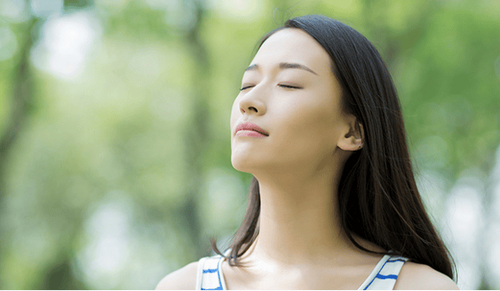
Hít thở sâu, tưởng tượng một số hình ảnh trong tâm trí sẽ giúp chúng ta cảm thấy thoải mái hơn
2.3.3. Muscle relaxation
In this breathing technique, you inhale while tensing a muscle group and exhale while relaxing that muscle group. Relaxing muscles can help us feel good both physically and mentally. Steps to perform muscle relaxation techniques include:
Lie comfortably on the floor or bed. Take a few deep breaths to relax. Breathe in. Foot muscle tension. Expiratory. Release the tension in the feet. Breathe in. Stretch leg muscles. Expiratory. Release the tension in the calves. Move in your own way. Tighten each muscle group. This includes legs, belly, chest, fingers, arms, shoulders, neck and face. The way we breathe is sometimes an effective method to relieve stress and fatigue in life. Scientists encourage people to breathe deeply to reduce feelings of anxiety as well as limit unnecessary energy consumption. For people who often encounter pressures in life, they can try to apply some breathing techniques such as: Belly breathing, breathing in the rhythm of 4-7-8, rolling breathing, performing breathing exercises. in the morning... to help improve your mood and overall health.
Please dial HOTLINE for more information or register for an appointment HERE. Download MyVinmec app to make appointments faster and to manage your bookings easily.
References: uofmhealth.org, webmd.com, nhs.uk




